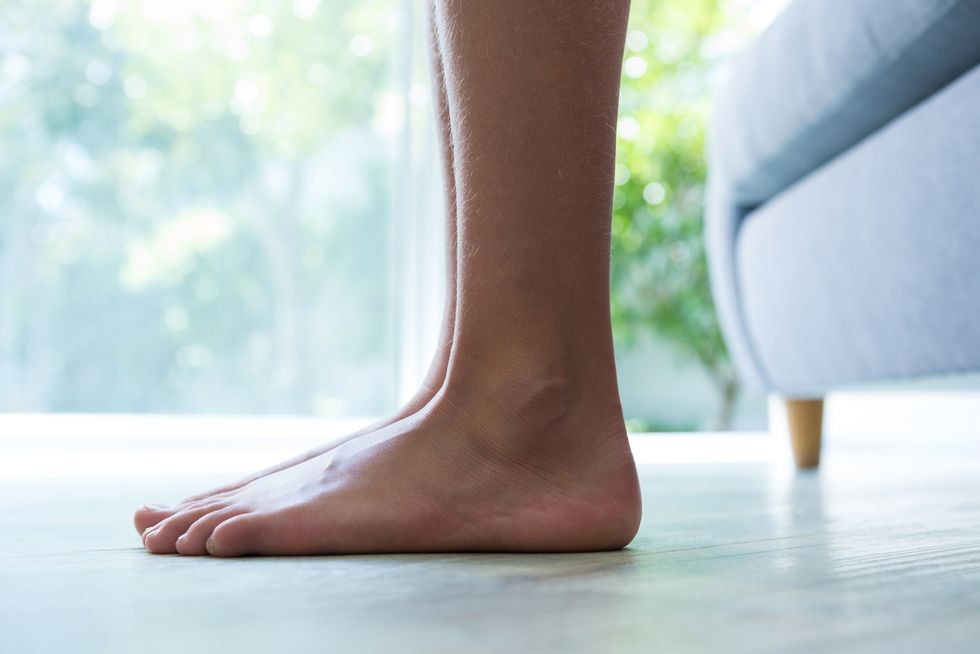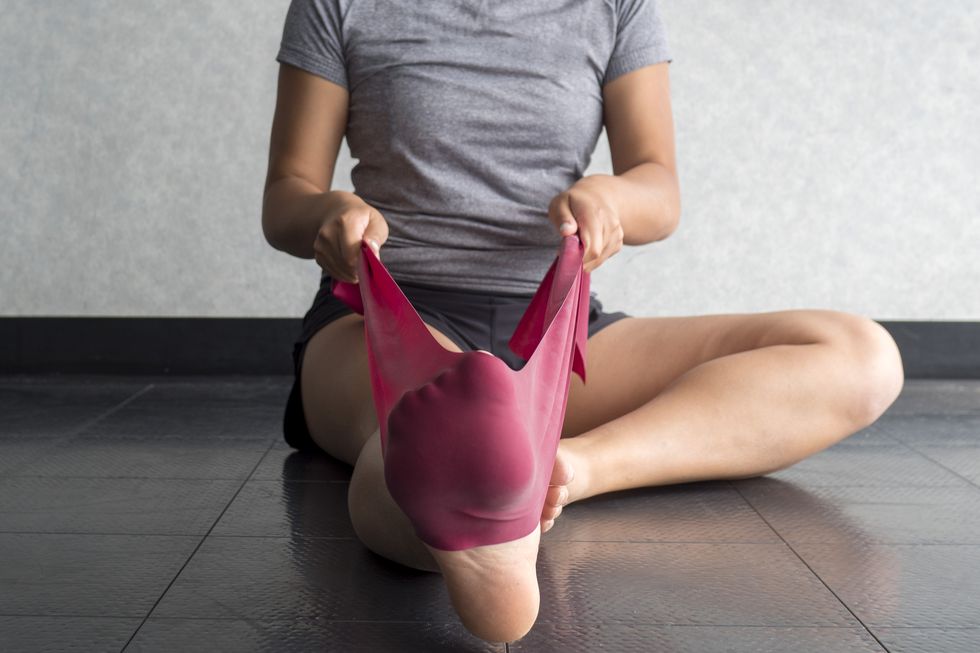6 Exercises That Can Help Address Over-pronation
Before you reach for that motion-control shoe or orthotic, you might be able to solve your problems with some good ol’ strength training.
If your feet and ankles roll inward when you run, we’ve got some news for you: You’re an over-pronator. While that’s not necessarily a bad thing (or a good thing), in some cases, over-pronation can lead to discomfort or even injury.
Don’t fret! Runner’s World spoke to Timothy Curran, doctor of podiatric medicine at Tufts Medical Center, and Kris Ferrara, doctor of physical therapy who specializes in running injuries at Moss Rehab, to bring you some answers and overpronation exercises. With their help, you can uncover what over-pronation really is, how it affects your running and the moves you can do to mitigate its potential problems.
What is overpronation and why does it occur?
When your foot strikes the ground, it’s supposed to naturally roll inward to adapt to the surface on which you’re running and allow the ankle to bend as your body passes over your feet, Curran tells Runner’s World. When you continue in the gait cycle, your foot should then roll back outward, or ‘supinate,’ to prepare for push-off.
When you over-pronate, though, your arch flattens to an excessive degree, and your foot rolls aggressively inward. Then, when you go to step forward, your foot doesn’t supinate back before takeoff. “It weakens that whole mechanism that allows us to push off the ground and spring off of the big toe,” Curran says. While over-pronation often occurs in runners with naturally flat arches, that’s not the only reason it can happen.
“It can be structural, or it can be a dynamic collapse,” Ferrara tells Runner’s World.
To diagnose structural over-pronation, Ferrara looks at the foot for a flat arch. “If someone has a really flat foot and a minimal arch, then they’re probably going to rotate more than someone who has a high arch,” he says.
If you have a high arch but are muscularly weak throughout the kinetic chain, then you likely experience dynamic over-pronation. “If a runner has weakness in their glutes and external rotators and up through the leg, pelvis, hip, and back, it can also lead to some pronation, especially in more dynamic activities like running,” Ferrara says.
Regardless of whether you over-pronate dynamically, structurally, or a combination of the two, the motion can potentially lead to injuries.
Curran names shin splints and IT band syndrome as just a pair of potential ailments. One small case study published in Clinical Research on Foot & Ankle agrees that preventing over-pronation can also help you sidestep IT band syndrome, while a systematic review in the Journal of Athletic Training, solidifies the relationship between shin splints and over-pronation.
Before you sprint to your local running shoe store to pick up chunky motion-control shoes or expensive orthotic inserts, however, know that there are some ways to address overpronation before you take that step.
“The tendency is to put over-pronators in an orthotic,” says Curran, who sees many patients make things worse by going straight into an orthotic instead of talking to a professional. While you might need an orthotic eventually, first try some key strength and flexibility exercises to see if you improve your over-pronation.
Exercises you can do to mitigate overpronation
Neuromuscular foot exercises
The following three exercises are meant to improve neuromuscular control over your feet. Ferrara says these improve “the ability for the brain and the nervous system to move the muscles, and therefore move the toes, in the way that they should be moving.” As a result, your brain works to more affectively stabilise your foot muscles, reducing overpronation.
Toe yoga
Why it works: If 20 reps throughout the day sounds like a lot, Ferrara says that most people see quick improvement because it’s not an exercise that requires you to become physically stronger to improve. You simply become more co-ordinated, connecting your brain to the muscle movement.
Arch lift
How to do it: Sit down in a chair, with feet and toes flat on the ground. Focus on lifting arch off the ground without clawing or bending toes into the ground. Relax. Repeat for as many reps as possible. Do 3-4 total sets, resting 30 seconds between sets.
Why it works: Arch lifts accomplish a similar outcome to toe yoga. “It’s a tough one because people don’t know how to activate the muscle, on top of the muscle being weak,” Ferrara says. As you improve, you can make it more difficult by standing, then standing only on one foot. Eventually, it grows into a balance exercise, as well as a neuromuscular one.
Band exercises
The next set of over-pronation exercises use bands to target other muscle groups that stabilise your body when moving. As a result, you experience less external rotation throughout your kinetic chain, which can help prevent over-pronation.
Banded gas pedal
How to do it: Sit down on the floor with one leg straight out. Wrap a regular, unlooped band around the ball of your foot, holding each end in hands far enough away to create tension. Like you’re pressing a gas pedal, push down, and then turn foot inwards. Release and bring toes back up. Repeat for as many reps as possible. Do 3-4 total sets, resting 30 seconds between sets.
Why it works: The exercise doesn’t target the arch, Ferrara says, but instead works on your posterior tibialis—a tendon that runs from your calf down to the arch of your foot. This tendon pulls up the arch, preventing flat-footedness and collapsing. By strengthening the tendon, you actively counteract the collapsing of your arch.
Band walk
How to do it: Place a looped resistance band around ankles and stand with feet hip-width apart. Squat slightly while keeping an upright posture. Keeping feet hip-width apart, step one foot forward, then the other, until fatigued. Take a 30 second rest, then walk back to starting point. You should feel it in hips and glutes. Repeat for as many reps as possible. Do 3-4 total sets, resting 30 seconds between sets.
Why it works: Many external rotation issues, like overpronation, point back to weak glutes, says Ferrara. So by strengthening that area, you’re actually helping to prevent overpronation.
Glute exercises
Strong glutes improve your entire gait cycle, including your foot strike and push-off. Every runner should do glute exercises, but over-pronators will experience less, well, over-pronation.
Glute bridge
Clamshell
How to do it: Lie on side with legs stacked. Bend knees slightly in front of you. While keeping lower leg on the floor and feet stacked, lift the top leg up until you feel it in your glutes. After holding for a few seconds, bring leg back down. For an added challenge, wrap a band around thighs. Repeat for as many reps as possible. Then repeat on the other side. Do 3-4 total sets, resting 30 seconds between sets.
What if overpronation exercises don’t work?
If you try these exercises and your over-pronation still hasn’t improved, then Curran says it might be time to look into orthotics and stability shoes. But before you buy anything, talk to a podiatrist. They may recommend you see a personal trainer to asses your gait, or they may prescribe you insoles outright. If there’s still no improvement after all that, Curran says there could be another problem.
“I think for most runners the issue is overuse,” says Curran. “So if they run into problems when they’re trying to increase mileage or they’re having trouble or pain in their feet or ankles, they may want to take a step back and get it evaluated.”
While they are only one piece of your running puzzle, Curran stresses the importance of healthy feet: “They really are the foundation of the body and contribute quite a bit to how other parts of our legs, hips, and back work.”
READ MORE ON: over-pronation strength exercises



